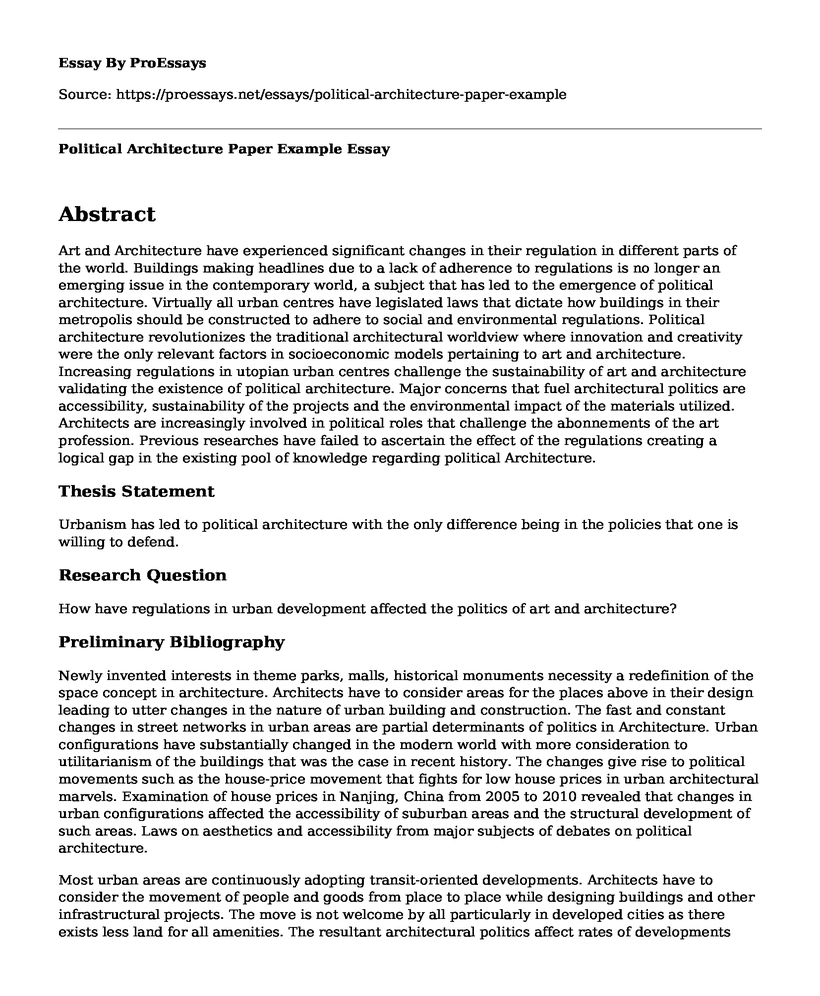Abstract
Art and Architecture have experienced significant changes in their regulation in different parts of the world. Buildings making headlines due to a lack of adherence to regulations is no longer an emerging issue in the contemporary world, a subject that has led to the emergence of political architecture. Virtually all urban centres have legislated laws that dictate how buildings in their metropolis should be constructed to adhere to social and environmental regulations. Political architecture revolutionizes the traditional architectural worldview where innovation and creativity were the only relevant factors in socioeconomic models pertaining to art and architecture. Increasing regulations in utopian urban centres challenge the sustainability of art and architecture validating the existence of political architecture. Major concerns that fuel architectural politics are accessibility, sustainability of the projects and the environmental impact of the materials utilized. Architects are increasingly involved in political roles that challenge the abonnements of the art profession. Previous researches have failed to ascertain the effect of the regulations creating a logical gap in the existing pool of knowledge regarding political Architecture.
Thesis Statement
Urbanism has led to political architecture with the only difference being in the policies that one is willing to defend.
Research Question
How have regulations in urban development affected the politics of art and architecture?
Preliminary Bibliography
Newly invented interests in theme parks, malls, historical monuments necessity a redefinition of the space concept in architecture. Architects have to consider areas for the places above in their design leading to utter changes in the nature of urban building and construction. The fast and constant changes in street networks in urban areas are partial determinants of politics in Architecture. Urban configurations have substantially changed in the modern world with more consideration to utilitarianism of the buildings that was the case in recent history. The changes give rise to political movements such as the house-price movement that fights for low house prices in urban architectural marvels. Examination of house prices in Nanjing, China from 2005 to 2010 revealed that changes in urban configurations affected the accessibility of suburban areas and the structural development of such areas. Laws on aesthetics and accessibility from major subjects of debates on political architecture.
Most urban areas are continuously adopting transit-oriented developments. Architects have to consider the movement of people and goods from place to place while designing buildings and other infrastructural projects. The move is not welcome by all particularly in developed cities as there exists less land for all amenities. The resultant architectural politics affect rates of developments across urban centres. Changes in land use affect the rates of architectural development in a state. Wu and Cho researched the states of California, Idaho, Washington, Oregon and Nevada and ascertained that land use changes led to a reduction in the availability of developed land by about 10%. Washington state showed the highest decrease while Nevada showed the least. The research concluded that art and architecture thrive in areas with high uncertainty on the returns on land and architectural projects.
The research methodology applied will focus on the changes in urban architecture over time to show a correlation between architectural politics and changes in urbanism. The changes span from building materials, infrastructural designs, support systems among others that influence the art of architecture. Previous studies on the topic have all showed significant differences in architectural politics that inherently lead to positive and adverse effects.
Bibliography
Castello, Lineu. Rethinking the meaning of place: conceiving place in architecture-urbanism. Routledge, 2016.
Dittmar, Hank, and Gloria Ohland, eds. The new transit town: best practices in transit-oriented development. Island Press, 2012.
Petty, James. "The London spikes controversy: Homelessness, urban securitisation and the question of 'hostile architecture'." International Journal for Crime, Justice and Social Democracy 5, no. 1 (2016): 67-81.
Wu, JunJie, Bruce A. Weber, and Mark D. Partridge. "Rural-Urban Interdependence: A Framework Integrating Regional, Urban, and Environmental Economic Insights." American Journal of Agricultural Economics 99, no. 2 (2017): 464-480.
Wu, JunJie, Cho, Seong-Hoon. "The effect of local land use regulations on urban development in the Western United States." Regional Science and Urban Economics 37, no. 1 (2007): 69-86
Xiao, Yang, Chris Webster, and Scott Orford. "Identifying house price effects of changes in urban street configuration: An empirical study in Nanjing, China." Urban Studies 53, no. 1 (2016): 112-131.
Cite this page
Political Architecture Paper Example. (2022, Nov 20). Retrieved from https://proessays.net/essays/political-architecture-paper-example
If you are the original author of this essay and no longer wish to have it published on the ProEssays website, please click below to request its removal:
- Donald Trump's Presidential Announcement Speech
- "Where Do the Mermaids Stand?" - Voice and Body in The Little Mermaid movie By Laura Sells
- The Solution for Overcoming Barriers of Green Road Construction in Developing Countries - Essay Sample
- Why the Business Corruption in Show 'The Mechanism' Takes Place? - Research Paper
- Blind Side - Movie Analysis Essay
- Essay Example on Spoken and Written Texts
- Essay Example on American Elections







